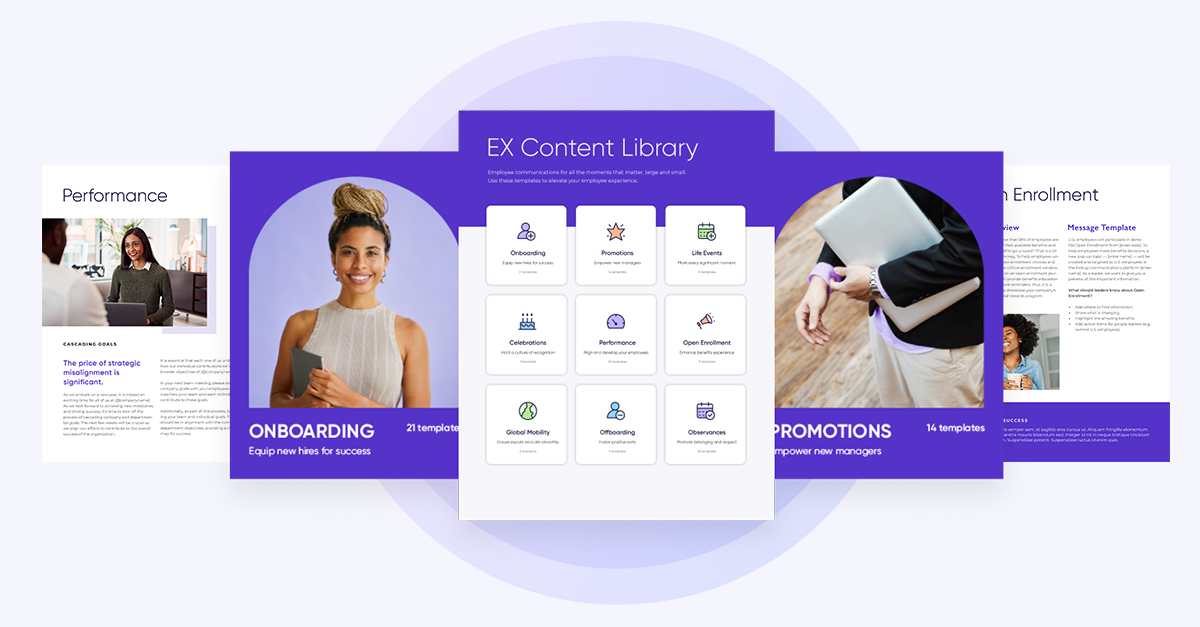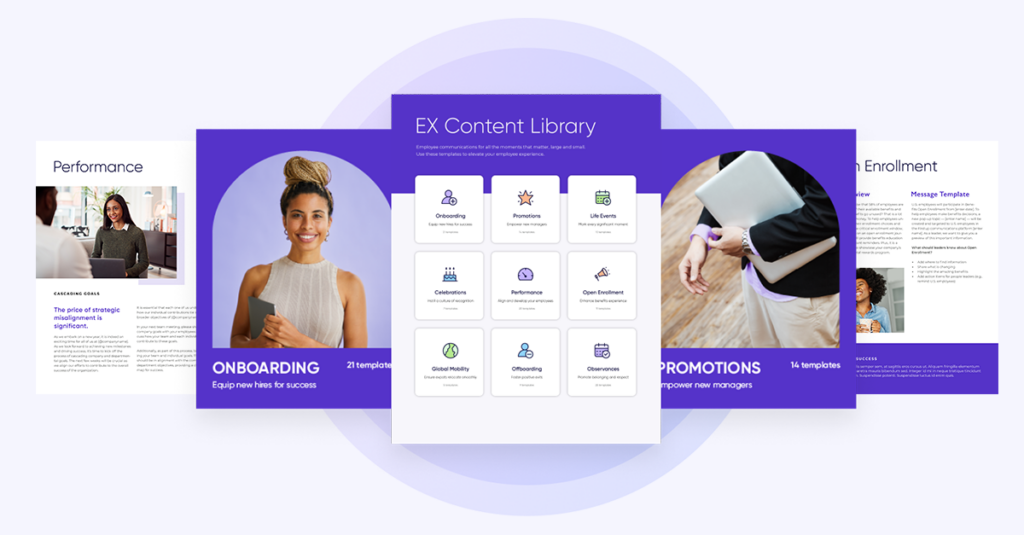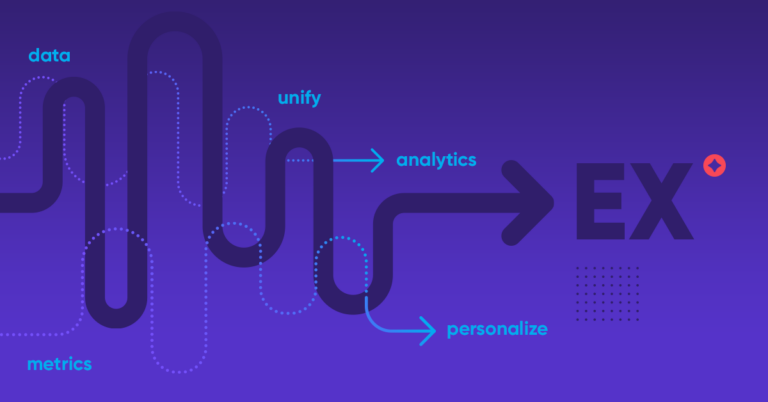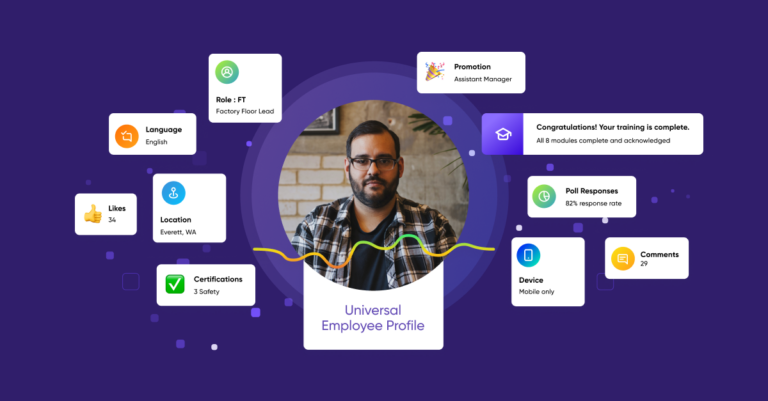In recent years, companies have transitioned from a ‘customer-centric’ to an ’employee-centric’ mindset, recognizing that a positive employee experience (EX) is a competitive advantage. Studies show that focusing on EX directly impacts productivity, workplace culture, and profitability, making employers more attractive in the job market.
Productivity, effectiveness, and engagement levels of employees influence everything from workplace culture to profits and growth. This article will define employee experience, explore its key components, and provide strategies for HR professionals to measure and improve it effectively.
What is Employee Experience (EX)?
Employee experience is the sum total of a worker’s experiences at a company. This includes cultural experiences with coworkers, leaders, and HR, user experiences with workplace technology, and physical workspace environments. Much like customer experience (CX), which covers all consumer interactions with a brand, EX covers all employee interactions within an organization. Employees are viewed as internal customers, particularly in departments like communications, HR, and IT.
Although employee experience is a broad umbrella term, there are 5 key factors that influence it:
Key components of employee experience
Interactions with management
Interactions with management are pivotal in shaping the employee experience. The 2024 Q12 Gallup poll of over 2.7 million workers reveals that managers account for 70% of the variance in employee engagement, highlighting the critical role of effective leadership. Great managers can serve as mentors, driving productivity and inspiring passion in their teams.
Team interactions
Team dynamics significantly influence daily work life. Workgroups with positive dynamics foster trust and psychological safety, leading to enhanced collaboration, creativity, and productivity. Utilizing tools like the Atlassian Team Playbook can help evaluate and improve team health, thereby elevating the overall employee experience. According to Gallup, teams with high engagement rates are 21% more productive and have 59% lower turnover.
Interactions with the company
Organizational interactions, such as CEO town halls and HR communications, impact employee engagement. Quality two-way communication fosters a sense of being heard and valued, enhancing overall engagement.
The employee life cycle or employee journey
The employee life cycle, or ELC, refers to the sequential milestones the employee experiences at an organization. Some companies, including ours, call this the employee journey because it invites comparison to the customer journey companies use to design their customer experience.
The employee journey has 7 stages: candidates are recruited, onboarded, engaged, perform their role, are developed/promoted, and finally exit the company. Their exit turns them into company alumni, and the journey can become cyclical when company alumni rejoin the organization or refer new talent. The HR department typically “owns” the ELC, but many different leaders and managers can impact it at various touchpoints.
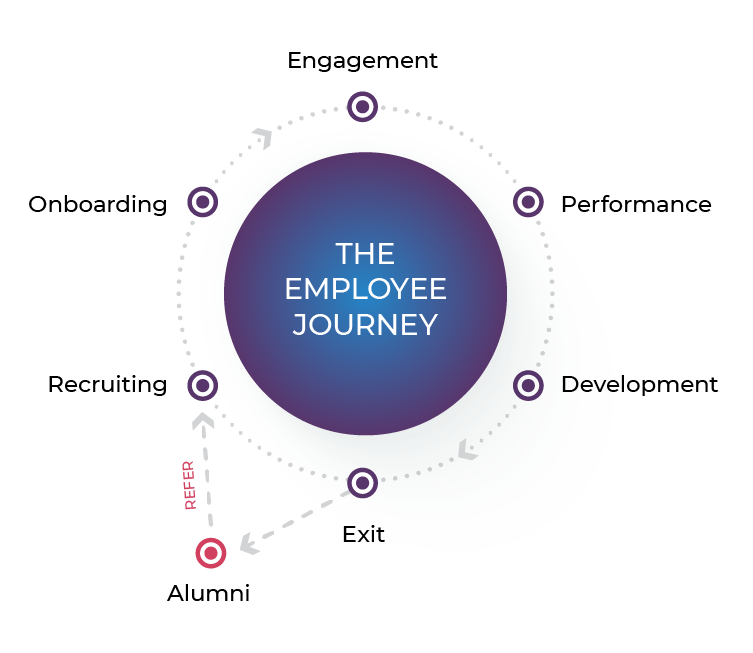
Start elevating your employee experience with 125+ templates for personalized employee journeys
Interactions with technology
The digital employee experience (DEX) encompasses interactions with various software, hardware, systems, and applications. According to the same 2024 report, employees who are satisfied with their workplace applications are more likely to stay with their organization. The report highlights that seamless integration of these tools through HRIS systems can greatly enhance DEX. Additionally, ensuring that employees have the right digital tools and resources can lead to higher engagement and productivity.
Digital employee experience vs physical employee experience
Because human factors are challenging to influence, companies that want to make immediate changes often focus on either the digital employee experience or the physical one.
Digital employee experience
Different roles within an organization experience technology differently. Desk workers often face a deluge of emails and notifications, causing frequent context-switching, while deskless workers may lack access to essential digital tools. According to the Gallup report, 46% of employees are dissatisfied with their workplace applications, highlighting the need for improved digital experiences.
Studies show that these different experiences lead to different challenges. Desk workers are often overwhelmed, receiving a deluge of emails, pings and notifications, forcing them to context-switch as often as 400 times a day. They may also have to manually log into different systems to find information. In a recent study, 45% of respondents felt this made them less productive at their job. Meanwhile, deskless workers often lack digital capabilities—in our survey of IT professionals, 72% of them admitted their deskless workers don’t have access to the same employee engagement tools their desk workers use. And, this number is only likely to increase in the coming years.
This dissatisfaction and lack of productivity underscores the importance of enhancing digital experiences through AI-powered intelligent communication platforms to increase employee engagement and productivity.
Physical employee experience
Physical work environments significantly influence how employees feel at work. Elements such as temperature, air quality, lighting, and noise conditions can impact concentration and productivity. According to Jacob Morgan, 4x best-selling author and founder of FutureofWorkUniversity.com, the physical environment constitutes 30% of the employee experience. And according to research presented in the journal Science Direct: “Temperature, air quality, lighting and noise conditions in the office affect the work concentration and productivity. Numerous studies have consistently demonstrated that characteristics of the physical office environment can have a significant effect on behavior, perceptions and productivity of employees.”
During the pandemic, the shift to remote work altered these dynamics further and left many more employees physically outside of the office. Years later, the nature of remote and hybrid work has become more common, making the management of the physical employee experience more difficult for companies to directly control.
For those employees that are physically at work everyday, like so many deskless workers, potential suggestions for improving the physical employee experience include making the common spaces more comfortable by adding air conditioning and redesigning breakrooms. Additional suggestions for improving the overall experience included support services, such as ordering dinner for employees’ families, as well as professional development and training opportunities.
Employee experience vs employee experience
Employee experience focuses on a worker’s entire experience during their lifecycle with the company, but employee engagement refers to how involved an employee is with their work. It covers elements of employee satisfaction, including how passionate workers are about their jobs, but it also refers to how aligned employees are with their organization, how committed they are to it, and how much discretionary effort they put into their work. Engaged employees understand their purpose within their company, how they fit in, and how they can help achieve business impact.
Want to learn more about engaging your workforce?
Why is employee experience so important?
The importance of employee experience extends beyond the employee journey, impacting organizational culture and business results. Research from Deloitte shows that nearly 80% of business leaders consider employee experience important or very important. Here are five critical areas impacted by employee experience:
5 critical areas impacted by the employee experience
Employee engagement and employee satisfaction
A positive employee experience leads to higher engagement and satisfaction levels. Engaged employees are more productive, stay up-to-date with company news, and seek better processes. Some organizations have created roles like Chief Employee Experience Officer to focus on improving the employee experience.
Talent recruitment
Candidates today look for meaningful work and positive work environments. A strong employee experience and culture can attract top talent, as potential employees often scrutinize company reviews, benefits, and diversity policies during the hiring process.
Employee retention
First impressions during the onboarding process are critical. Organizations that fail to provide the necessary tools and information from the start risk losing new hires quickly. Harvard Business Review highlights career development opportunities, culture challenges, and supervisor relationships as common reasons for employee turnover.
Customer experience
The link between employee experience and customer experience is well-documented. Companies with highly engaged workforces outperform their competitors by 147% in earnings per share. Glassdoor research shows that a 1-point increase in company rating is associated with a 1.3-point increase in customer satisfaction.
Profitability
Employee experience directly affects business success. According to IBM’s Smarter Workforce Institute, companies in the top 25% for employee experience report a 2x return on sales and nearly a 3x return on assets. Disengaged employees can cost companies between $450 and $550 billion annually, as per Gallup.
Statistics on employee experience (EX) and profitability
- Companies that score in the top 25% on employee experience report a 2x return on sales and nearly a 3x return on assets – IBM’s Smarter Workforce Institute
- EX leaders have 25% higher profits than competitors with poor EX – MIT
- EX leaders have 4x higher average profits, 2x higher average revenues, 40% lower turnover and 24% smaller headcount – Jacob Morgan for SHRM
- EX leaders beat out the average S&P by 122% – Accenture
- Disengaged employees can cost companies between $450 and $550 billion dollars a year – Gallup
Belonging drives engagement
How to measure the impact of employee experience
To elevate the employee experience, organizations must employ a data-driven approach to measure and analyze various aspects of the employee journey. Key performance indicators (KPIs) include:
Employee Engagement Surveys
Regular employee engagement surveys track metrics such as clicks, views, and time spent on content, providing insights into engagement levels and areas for improvement.
Pulse Polls
Short, frequent surveys provide immediate insights into employee feelings on specific topics.
User Experience Tracking
Monitoring the adoption and usage of workplace tools can reveal issues with digital employee experience.
Unified Analytics
Comprehensive dashboards that integrate data from various touchpoints and systems help in making informed decisions.
360-Degree Feedback
360-degree feedback systems gather comprehensive feedback from peers, subordinates, and supervisors, giving employees a well-rounded view of their performance.
Exit Interviews
Exit interviews provide insights into why employees leave the organization and what can be improved.
Continuous Listening
Implementing continuous listening strategies allows organizations to stay attuned to employee sentiment and promptly address concerns.
How to improve the employee experience
Need to make improvements to your EX? Don’t think of it as a major, overwhelming overhaul. Instead, break it down into incremental, manageable steps or tactics. Here are 7 ways you can use to get started.
1. Focus on performance management
Active listening skills and journey mapping
To enhance the employee experience, it is crucial to develop active listening skills among managers. This involves training managers to listen empathetically and respond effectively to employee concerns, fostering a supportive environment where employees feel heard and valued. Implementing journey mapping through employee polls or pulse surveys can measure employee sentiment at various touchpoints, providing data to identify areas for improvement.
2. Design an employee experience framework
Setting expectations throughout the employee journey
Create an employee experience framework that outlines the company’s shared purpose and values across all stages of the employee lifecycle, from recruitment to exit. Utilizing AI-powered intelligent communication platforms to personalize interactions at each stage can significantly enhance the overall experience.
Personalized moments along the employee journey
Use AI-powered intelligent communication platforms to personalize interactions with employees at different stages of their journey. Tailored messages and support can enhance the overall experience by addressing individual needs and preferences.
Employee Experience Strategy

3. Improve technology use
Ensuring seamless integration of tools and systems
Collaborate with your IT department to ensure all workplace tools and systems are seamlessly integrated. This reduces the need for employees to switch between multiple platforms, increasing efficiency and reducing frustration. Surveys indicate that a well-implemented digital employee experience can significantly boost employee satisfaction and retention.
Visual Aids and Infographics
Utilize visuals to demonstrate how integrated tools and systems streamline workflows and enhance the digital employee experience. Infographics can effectively illustrate the benefits of seamless technology integration.
4. Build a culture of transparency
Creating Direct Communication Channels and Feedback Mechanisms
Establish direct communication channels between leadership and employees. This can be achieved through dedicated content streams for senior leaders to post updates or informal messages. Open communication fosters trust and makes employees feel valued.
Highlight the Role of Culture and Leadership
Emphasize the importance of transparent leadership in fostering a positive culture. Leaders should model open communication and actively seek employee feedback. Regular updates and transparent decision-making processes can enhance trust and engagement.
5. Develop a Strong Company Culture
Emphasize Core Values and Vision
Ensure the company’s core values and vision are consistently communicated and reflected in everyday practices. A strong company culture aligns employees with the organization’s goals and fosters a sense of belonging.
Employee Recognition Programs
Implement employee recognition programs to celebrate achievements and contributions. This can include awards, public recognition, and other forms of acknowledgment that make employees feel appreciated and motivated.
6. Enhance Physical Work Environment
Investing in Hybrid Workspaces
As companies transition back to the office, investing in hybrid workspaces that accommodate both remote and in-office employees is crucial. This includes flexible seating arrangements, collaborative spaces, and technology that supports virtual connectivity.
Improve Conditions for Frontline Workers
For roles that cannot be performed remotely, such as factory or field workers, focus on improving physical conditions. This can include better air conditioning, comfortable break rooms, and other amenities that enhance the work environment.
7. Support Professional Development
Career Development Opportunities
Offer professional development opportunities that allow employees to grow within the organization. This includes training programs, mentorship, and clear pathways for advancement.
Continuous Learning and Development
Encourage a culture of continuous learning by providing access to educational resources and supporting employees in their professional growth. This not only benefits the employees but also contributes to the organization’s overall capability.
Detailed Actionable Steps for Performance Management
- Conduct Regular Check-ins: Schedule frequent one-on-one meetings between managers and employees to discuss progress, challenges, and career aspirations. These sessions should be used to provide constructive feedback and recognize achievements.
- Set Clear Goals: Establish SMART (Specific, Measurable, Achievable, Relevant, Time-bound) goals for employees to ensure they have a clear understanding of expectations and can track their progress.
- Implement Feedback Mechanisms: Utilize tools like 360-degree feedback systems to gather comprehensive feedback from peers, subordinates, and supervisors, giving employees a well-rounded view of their performance.
- Offer Training Programs: Provide training sessions for managers to develop their active listening and coaching skills, ensuring they can effectively support their teams.
- Utilize Performance Analytics: Leverage HRIS systems to track performance metrics and identify trends or areas needing attention.
Conclusion: The employee experience calls for collective responsibility
Improving employee experience is a continuous process that requires the collective effort of HR leaders, C-suite executives, managers, and IT professionals. By focusing on performance management, integrating effective technology, fostering a transparent and strong company culture, and supporting professional development, organizations can create a positive and engaging environment for their employees. This not only enhances employee satisfaction and retention but also drives business performance and success.
Implementing these employee experience strategies will help organizations stay competitive and ensure they are among the elite companies that truly prioritize and excel in employee experience management. By leveraging data-driven insights and continuously evolving their approaches, companies can create an exceptional employee experience that benefits both the employees and the business as a whole.
FAQs
An employee experience strategy is a comprehensive plan designed to enhance the overall employee experience by aligning organizational practices with employee needs and expectations.
Employee experience surveys are crucial for gathering employee feedback, identifying areas for improvement, and ensuring that employee experience initiatives are effective.
Feedback provides valuable insights that help organizations refine their employee experience strategy, leading to a more positive employee experience and increased employee engagement.
A positive employee experience boosts employee engagement, which in turn improves customer satisfaction as motivated employees are more likely to provide excellent service.
Employee engagement is a key outcome of a well-executed employee experience strategy, where engaged employees are more committed, productive, and aligned with the organization’s goals.
An employee experience framework helps structure and guide the implementation of an employee experience strategy, ensuring consistent and effective management of employee touch points throughout their journey.
The stages of the employee lifecycle encompass recruitment, onboarding, engagement, performance, development, retention, and exit. Each stage of the employee lifecycle significantly influences the overall employee experience.



